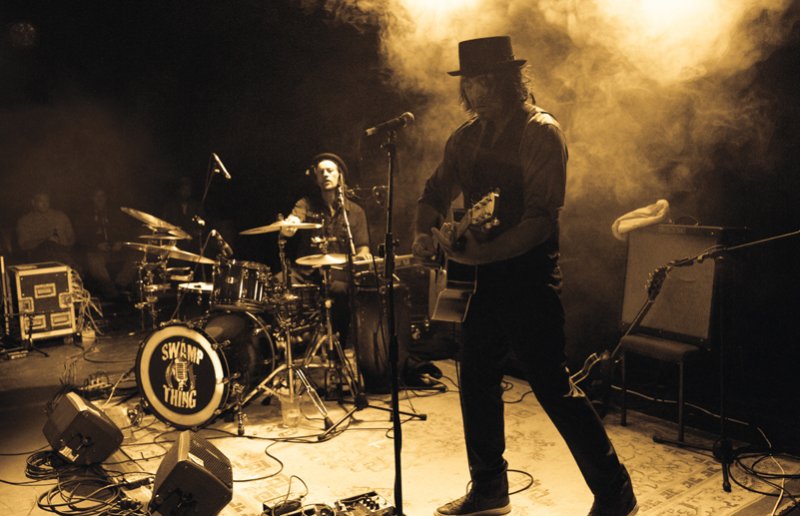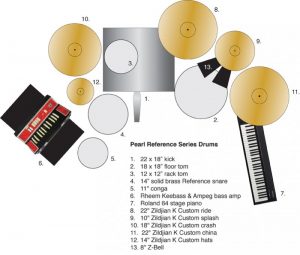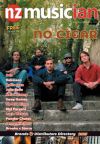Get Yer Kit Off: Michael Barker
Get Yer Kit Off: Michael Barker
I’ve been playing since I was 12 years old and Im 47 now.
You come from a big, talented family. What was going on in the household to make you want to play music?
Music was an integral part of our family life. My mum was a singer and she passed that on to most of the family. My elder brother Doug was a drummer. I looked up to Doug and from there I decided I wanted to play the drums.
In your early days who were your influences?
English rock drummers. Listening to Ian Pace, John Bonham and Budgie from Siouxsie and the Banshees, some new wave and punky kind of drummers. There was some stand out drummers in that field. Also some of the funk drummers from the US, a band like The Meters. Once I listened to them I started to understand where their influences were coming from. I use to think they invented everything they played, and then I realised Ian Pace and John Bonham were listening to Buddy Rich, and Buddy Rich was listening to say, Baby Dodds. Everyone has their influences, so just digging deeper and finding more information and learning from those threads of drumming styles.
 Did you have any formal training?
Did you have any formal training?
I pretty much learnt by ear all the music around me and by watching other people. Actually I learnt a lot from watching you Mickey, so that was later in my teens before I moved to Australia. I’d come up to the Tudor Towers and watch you play in Cairo.
I did have formal training but that wasn’t until I had lessons in Australia. I moved to Melbourne in 1985 and went to the Box Hill College of TAFE, which is like a polytech. I did two years of drum and percussion lessons with a bloke named Bruce Barber – a fantastic teacher who took me back to basics and reviewed my stick technique. I learnt a variety of styles; Latin, jazz, funk and shuffles and was introduced to orchestral percussion. I focused a lot of my efforts in lesson time on learning to play xylophone, timpani, snare drum and auxiliary orchestral percussion with a view to audition for an academy for orchestral musicians.
That two-year period between 1985 and 1986 set me up for an audition for a three year orchestral music course at the Victorian College of the Arts, where I continued my formal percussion studies with another bloke called Barry Quin. He had a vast knowledge of percussion and music having played percussion for the BBC Symphony Orchestra for many years and working as a freelance percussionist in London through the late ’60s, ’70s and early ’80s. That was five years of intense formal training and interspersed with that, I was out playing gigs on the drum kit, basically to pay my bills and have fun.
Did you ever try to emulate drum licks from your favourite drummers?
I remember that tune, The Immigrant Song by Led Zeppelin – I played that for hours and hours and hours badly, because I didn’t have formal teaching. I thought practice was just jumping on the drums and playing the beats you liked. It was a form of practice but with that particular beat it helped me to develop a reasonable amount of technical facility with my right foot on the bass drum pedal. Inadvertently John Bonham becomes my mentor and teacher by learning a rogue style like that. You don’t learn the technique, you just make do to find a way.
Did you ever have vinyl records where you slowed the licks down?
I did do that, it was a good technique. A program that I found on the internet many years ago called the Amazing Slow Downer does the same thing. I found this to be very useful because it slows it down without changing the pitch – it gives you that digital glitchy sound but essentially it provides the same facility.
Any books you’d recommend to budding drummers?
There are some staple books that have lasted over the years and the reason why they’ve lasted is because they are really great. One that comes to mind is Syncopation by Ted Reed. There are various applications for that book. You can swing it. It’s good for your co-ordination, you can read the left hand parts and try different ostinatos underneath that. I found it really helpful.
Another one is Stick Control by George Lawrence Stone. I find there are some modern books that cover rudimental grounding but I see quite a bit of these exercises pretty much lifted out of this book. A drumkit book I have found useful and I teach out of is a Frank Corniola book called Rhythm Section Drumming. It has backing tracks and covers different styles. There are many snare rudimental books out there and you can tend to get a bit overwhelmed but these books will sort you out.
How important do you think reading music is?
I relate reading music to reading books written in English or whatever language. Music is a language and you have to learn the vocabulary so you can speak the language. Reading is helpful but it’s not the only thing because one can recite stories that you hear in a way that you hear a joke and you recite it later. I think reading music is a very helpful way of learning but also passing on knowledge.
In a studio session for artists do they give you charted material to read or do you rehearse and improvise on the spot?
I find less and less people give me charts to read. They might give me something like a map or a rough idea of the pattern they are after. More often than not, in fact 90% of the time I’ve ever gone into a recording studio there has been no chart. I don’t mind that and maybe I get booked for that reason that I can play it on the fly. With percussion sessions I used to do in Melbourne with orchestral scores, the music would be charted and fairly accurately charted.
I did a movie fairly recently called Mr Pip and there was nothing written for that. I did double some violin parts on marimba but the rest of the session was creating an atmosphere. Watching the screen and basically interjecting with sound to create tension and drama.
Are you able to make a living out of studio work?
For me trying to create an income stream from various facets of the music industry is challenging. That’s why I teach music, not only because I enjoy it, but also its a way of having a semi-regular income and going out and playing live. Its like a component of your income for me anyway.
Do you have a practice regime?
I do. I use Vic Firth practice marching sticks that are heavier. The theory behind that is if Im using heavier sticks to practice with, when I pick up my light sticks I’ll be faster. I certainly like using those big sticks. I start off very slow playing flams because within a flam you play a quiet note and a loud note. So youre practising two different dynamics and the co-ordination involved if you go hand to hand flams. I just start off warming up like that then move into more technically demanding rudiments. That would be at least half an hour of that just to keep my wrists, fingers and hands in the right place.
 Do you use rudiments around the drumkit?
Do you use rudiments around the drumkit?
If you drill yourself in rudimental practice, those become part of your musical vocabulary. As you go to tell your story on the drums, if you happen to have those moments in the music where you can express yourself in a solo or a little drum break, I think once youre drilled and versed in rudimental drumming the rudiments come out as part of the vocabulary. Everything is a combination of a single and a double stroke – sure, you have triples but theyre just singles. In the same way as in knitting there are two types of stitches, knit and pearl. In drumming theres only singles and doubles and in digital data theres only zeros and ones. Whether you think you are, or not, you are playing rudiments of some kind.
What do you think is good practice for the beginner?
Playing along to music that you love and having fun with it is a start. Get together with other musicians to jam. I would have an emphasis on just enjoying it, using it as a release for emotion. Bringing that energy and focusing it in a positive way. Honing in on some technical aspects like rudiments and playing in time using a metronome to keep you honest. Learn the discipline of playing time rather than playing fast.
Practice slow, medium and fast and play different styles.

